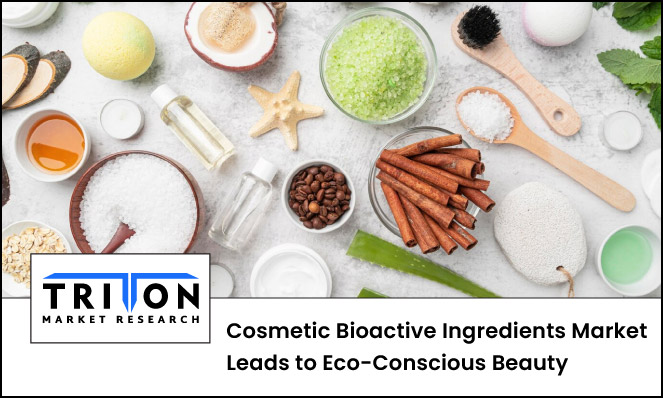



22, October 2024

As per Triton Market Research’s report, the Global Cosmetic Bioactive Ingredients Market is likely to grow with a CAGR of 5.34% in the forecast period 2024-2032. But what exactly are these bioactive ingredients, and how do they revolutionize the cosmetics industry?
As the world of beauty and skincare is evolving, consumers are becoming more concerned about the ingredients in their products. Increasing demand for organic beauty products and a shift toward sustainability have paved the way for bioactive ingredients to take center stage in the cosmetics industry. Cosmetic bioactive ingredients are naturally derived compounds, often from plant, marine, or microbial sources, that have biological activity when applied to the skin. These ingredients interact with skin cells at a molecular level, promoting various functions such as hydration, protection, anti-aging, or skin regeneration.
Explore in detail about this market in our FREE sample
A recent study found that 46% of women prefer to purchase beauty products formulated with natural ingredients. This clearly indicates the rising preference toward natural compounds over synthetic chemicals in their skincare routines. One of the primary reasons why users actively choose cosmetics made with natural ingredients is due to their formulation and effect on the skin. Traditional chemical cosmetics often rely on synthetic compounds like parabens or sulfates that may offer immediate but short-lived results. In contrast, products with natural cosmetic ingredients work synergistically with the skin’s biology, providing longer-term benefits and minimizing potential irritations or side effects.
From a sustainability perspective, bioactive ingredients also align with the global push toward eco-conscious consumption. Due to increasing demand for organic beauty products, even cosmetic ingredient manufacturers are now focusing on reducing environmental impact by sourcing bioactive compounds responsibly and utilizing green technologies in product development.
Connect with our experts for a simplified analysis!
Let us explore the industry trends in cosmetic bioactive ingredients products that are leading to the path of eco-friendly beauty among consumers and cosmetic brands.
Opportunities for Halal-Certified Bioactive Ingredients
The 2023/24 State of the Global Islamic Economy Report highlights significant growth in the halal cosmetics industry, with Islamic consumers spending $84 billion on cosmetics in 2022. This opens the door for bioactive ingredient companies to develop halal-certified bioactives that can offer unique properties, such as specific antioxidants, anti-aging compounds, or hydration agents.
In fact, companies also incorporate blockchain technology or other traceability solutions to verify and communicate the halal status of their products. Their transparency assures compliance and also builds trust with consumers who prioritize transparency in their purchases. This can help bridge the gap between traditional Islamic values and modern skincare science.
Sustainability and Ethical Sourcing in Bioactive Ingredients
Advances in biotechnology enable the sustainable production of bioactive ingredients through microbial fermentation or plant cell culture. To minimize environmental impact, many companies are investing in green chemistry approaches, which `involve using sustainable solvents and energy-efficient processes to extract bioactive compounds.
In 2023, the company launched a new line of Diana Food bioactives specifically crafted for ‘Beauty from Within’ products. This range includes naturally sourced ingredients such as Type I collagen, vitamins C and A, and polyphenols extracted from various fruits.
Thus, sustainable practices include ensuring that marine resources are not over-exploited and that animal testing is minimized or replaced with alternative testing methods when developing bioactive products.
Personalized Formulations for Skincare Using Cosmetic Bioactive Ingredients
The first step in developing personalized skincare is assessing the individual’s skin condition using AI-powered tools or smartphone apps that capture high-resolution images. This can provide detailed insights into hydration levels and texture. Once data is collected, algorithms can recommend specific bioactive ingredients and concentrations that match the individual’s skin profile. For instance, a person with dry skin prone to aging might receive a formulation containing hyaluronic acid, ceramides, and antioxidant-rich plant extracts like green tea.
Furthermore, bioactive ingredients can be encapsulated in liposomes, microspheres, or nanocarriers to reach specific layers of the skin for maximum efficacy. Some formulations use multi-layered or sequential release technologies where bioactives are released at different stages over time, targeting specific skin concerns based on individual needs, such as daytime protection (antioxidants) and nighttime repair (peptides and retinoids).
As consumers become more knowledgeable about the ingredient list in beauty products, the demand for bioactive ingredients and cosmetic bioactive ingredient solutions will continue to grow, setting the stage for a new era of beauty that is as beneficial to the skin as it is to the planet. Brands that embrace these trends and continue to invest in research and development of bioactive ingredients will undoubtedly thrive in the competitive and fast-moving cosmetic bioactive ingredients industry.
Grab a Quick Read to Get a Comprehensive Analysis of This MarketAnswer: Sodium benzoate is a preservative commonly used in food and cosmetics, classified as Generally Recognized as Safe (GRAS) by the FDA [6]. Phenoxyethanol is also another ether used as a fragrance or preservative, regarded as practically non-toxic when ingested and non-irritating when properly diluted.
Q.2) What is the difference between active and inactive ingredients in cosmetics?Answer: Active ingredients tend to be more potent and deliver quicker results, while inactive ingredients support and sustain those effects over time. When combined, they create a more balanced and effective skincare regimen.

Prevalent cases of terrorist attacks in today’s world is increasing the need for severe standards of security for public safety, and the global market for biometric technology scrupulously accommoda..
Prevalent cases of terrorist attacks in today’s world is increasing the need for..